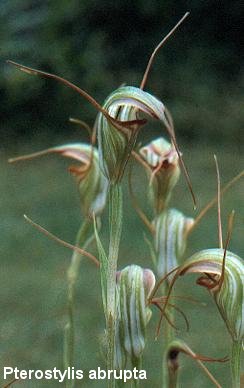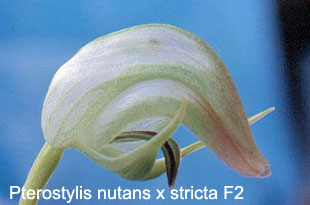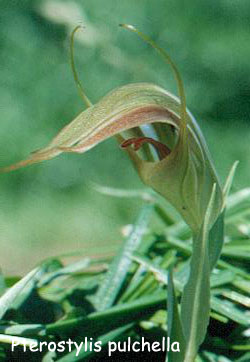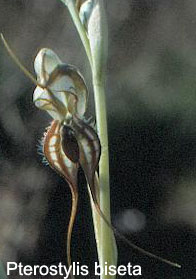Comments to the offered plants:

Pterostylis abrupta. Pterostylis abrupta is very easy to grow. In Middle Europe, the leaves emerge already in late May and flowering starts in middle of June. Forms colonies. Dormant from March until the end of May. Dry during dormancy. In summer, preferably outside on a shady place.

Pterostylis nutans alba X Pterostylis stricta F2. The best plants from the first generation were selected to breed the second generation. The flowers of F2 are clear white with erubescent tips. Easy to to grow.

Pterostylis pulchella. Pterostylis pulchella is restricted to New South Wales, Illawarra escarpments and Southern Highlands. Very rare on mossy rocks close to waterfalls. Threatened in nature. In culture in Middle Europe leaves emerge in July and flowering starts in August. Dry during dormancy from April to June.

Pterostylis biseta. Belongs to the rufa group Pterostylis. This group prefers dryer inland regions of southern Australia. Usually does not multiply. Absolutely dry during dormancy from June to September. Flowering from April to May, when the leaves start to wither.
Distribution:
Over 100 species, most are endemic to Australia. Some are found in New Zealand, New Caledonia and New Guinea.
Description:
Flower stems 5 to 60cm high, with a rosette of leaves on the base.
The dorsal sepal and petals are combined into a hood. The flowers are
mainly green with white, brown or redish suffusions.The moveable lip is
partially inside the hood, trapping small insects for pollination.
Culture:
Greenhoods are with a few exceptions easy orchids to grow and most
are colony forming and multiply at a rate of 2 to 5. The plants are summer
dormant (some exceptions) and rest as small, round tuberoids. Plants emerge
in late summer and flower in autumn, winter, spring or early summer. Culture
in light shade. Frost hardy up to -3°C. Regular watering during the growing
period is essential. Fertilize monthly with 0.3g/l until flowering. Reduce
watering gradually later in the season and stop as the leaves die back.
Completely dry during dormancy. Occasionally a light spray of water for
small plants and seedlings to prevent dehydration. If grown inside, move
plants temporary outside in late summer as cool nights and some rain will
stimulate plants into the new growing season. Repot every 1 or 2 years
at the end of the dormany.
Recommended potting mixes:
70% Seramis or fine to medium grade Perlite. 30% organic components.
Favourable are finely cut, fermented or N-impregnated wood shavings or
saw dust. (Toresa has given good results). No peat. Spagnum moss is suitable.
Some extra wood on top of the pot. Substrates have to be well draining
with a pH of 5 to 6.
Further reading:
Cultivation of Australian native orchids produced by the Australasian
Native Orchid Society, Victorian group Inc. Helen Richards, Rick
Wootton, Rick Datodi.
Orchids of Western Australia produced by the Western Australian
Native Orchid Study and Conservation Group. Kingsley W. Dixon,
Bevan J Buirchell, Margret T. Collins
Native orchids of Australia. David Jones, 1993. Reed,
ISBN 0 7301 0189 4.
Orchids of south-west Australia. Noel Hoffmann and Andrew Brown,
1992. University of Western Australia Press, ISBN 1875560130.
The Orchids of Victoria. Gary Backhouse and Jeffrey Jeanes, 1996.
Melbourne University Press, Carlton, Victoria. ISBN 584.1509945.
Field Guide to the Orchids of New South Wales and Victoria. Tony
Bishop, 2000. Second edition. University of New South Wales Press. ISBN
0 86840 706 2.